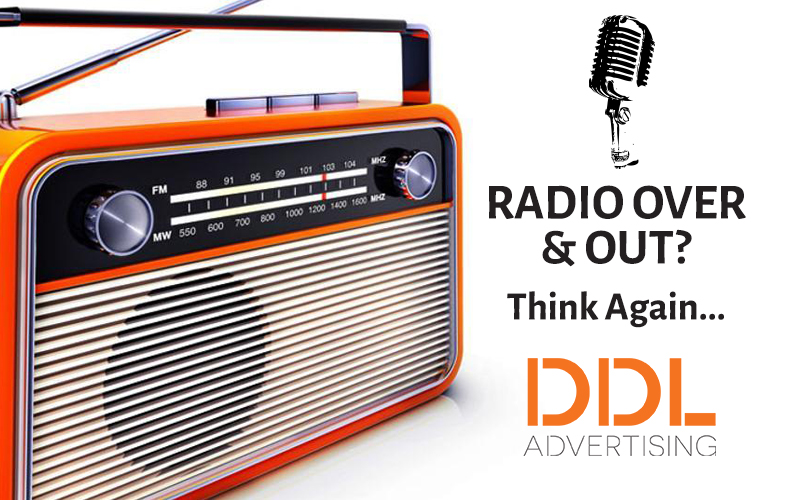Radio is not out. I repeat, radio is not out. Over.
Traditional radio is still a very relevant way to reach your target audience. According to Nielsen, traditional radio is an area advertisers can utilize and gain the right return for their investment. Radio exposure can truly make a difference in terms of conversion, particularly gaining new, valuable customers. Let’s dive into how it is so effective.

How is Traditional Radio Effective?
1. The PM Commute: Folks listen to the radio on their afternoon and PM commute as they commute home from work or school and tune in for weather updates, daily contest updates, or to listen to top indexing format, country radio stations. Baby boomers preferably listen to engaging talk shows or to call in to win contests, which is a great space for advertisers to leverage. On traditional radio, there is less interruption as on other mediums since drivers cannot be distracted with social media or texting while driving. 2. Reach: According to Edison Research, “AM/FM radio reaches an audience 10 times the size of ad-supported Pandora.” In the U.S., traditional radio reaches 65.2 million millennials ages 18-34 each week. It is without doubt that radio reaches a high number of the commuting population as they navigate to work or school on a daily basis. With penetration on an upward slope, Nielsen claims that 93% of adults 18-54 listen to radio per week. That’s quite a lot of people!

3. Listener Demographics: Of course the Gen X generation, ages 35-49, listen to radio more than other age demos at approximately 14 hours a week according to Nielsen. Unlike the millennial audience, this demographic generally listens between 10:00am and 3:00pm. The Hispanic market makes up 42.4% of the weekly radio tune-in nationally.
4. Contests: Stations often run contests and giveaways in which listeners can call in to win tickets or cash. This is an opportunity to create a landing page for the contest to gain further demographic information about your audience! Whether they are a winner requesting to receive the prize or a user interested in entering to win, you can include a lead form to request further information including their name, phone number, address, etc. Gaining this information is valuable to shaping exactly who your buyer persona is and how to target them effectively.
5. On Air Personalities: AM/ FM radio stations incorporate entertaining and upbeat on air personalities that listeners feel engaged with. Listeners rely on hearing their favorite radio personalities habitually as they commute to work, resulting in an undeniable opportunity to advertise on platforms potential customers are loyal to. According to the Radio Advertising Bureau, 75% of listeners tune in because they know their favorite personality is on-air nad 72% discussed what they heard from the personality with their friends. Live reads are a great way to endorse your business or service and on-aor personalities often voice from personal experience.


6. News/ Talk Shows: Surprisingly enough, news and talk radio stations still capture radio listeners at about a 9.8% audience share last year from January- September 2017. (according to Nielsen) 7. Added Value: Often times, radio stations offer live reads, endorsements, blinks, and sponsorships, which are great opportunities to air advertisements and act as the sponsor of weather reports or news updates
In the Digital Direction:
Digital internet radio has made its stomp in the industry as market leaders like Pandora, Spotify, and Apple Music continue to innovate. According to Statista, the top monthly online radio users are ages 12-24 at about 87% followed by 25-54 at 70%. Pandora are in a face to face competition as to which provides consumers the best benefit bundle for their buck. Although they are close competitors, Spotify continues to tops the charts of active users at about 140 million as of June 2017 and 81 million for Pandora in December 2016. There is much innovation to come in the digital world. Amazon is exploring ways to incorporate ads into the Echo and Alexa. They are looking into two approaches: promoted search results and past shopping habits. The search results approach would read top sponsored or promoted results as matching the search query. There are risks associated with this method since users may be more likely to isolate Amazon products is they become swarmed with ads. The other method, promoted results, would offer suggestions based on search queries and past purchases.
How Do We Leverage Media In- House:
At DDL, we offer media services and have developed a number of media campaigns and recommendations for clients like RISLA, Seasons Corner Market, Paul Masse, and more. In fact, we provide clients with highly integrated and focused media plans that deliver results on the platforms best fit for their business objectives. From local traditional and digital radio to running television spots, our media reps help maximize our clients’ budget and exercise the plan with endorsements and added value to further incentivise the client to do future business. For television, we refer to coverage maps and HH demographics to gain insight on which locations and audiences will maximize the most reach.

Sources: Radio Advertising Bureau, Statista, The Infinite Dial 2017: Edison Research, Nielsen

